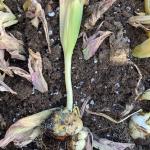Blue mold of tulips was diagnosed in the UMass Extension Plant Diagnostic Lab this week. Blue mold/bulb rot is caused by several species of the fungus Penicillium. P. corymbiferum, the species that most often attacks tulip bulbs, can proliferate at temperatures around 42°F (about 5°C). Penicillium species are ubiquitous in the soil. They are opportunistic pathogens that attack damaged or stressed plants. Bulbs typically become infected during harvest.
The disease begins as brown spots on the bulbs. Blue fungal growth may appear on the outside of the bulb and/or in between scales. Bulbs may fail to sprout, and those that do may have reddish, malformed, stunted foliage with necrotic tips.
Management: Freshly harvested bulbs may be treated with Cleary’s 3336TM (thiophanate-methyl), Kleen GrowTM (didecyldimethylammonium chloride), or another fungicide labeled for this purpose. See product labels for information. Do not save diseased or damaged bulbs. Bulbs should be handled carefully to avoid bruising. Store bulbs in a dry, cool area in onion bags or loose layers of peat or hay. Most other bulb crops are also affected, including onions, so rotating away from these crops for at least three years is recommended. Inspect bulbs carefully for signs and symptoms of disease prior to planting. Discard any diseased or damaged bulbs.
- Dr. Angela Madeiras, Extension Educator & Diagnostician, UMass Extension Plant Diagnostic Lab

